< more recent | 23-31 October 2024 | older >
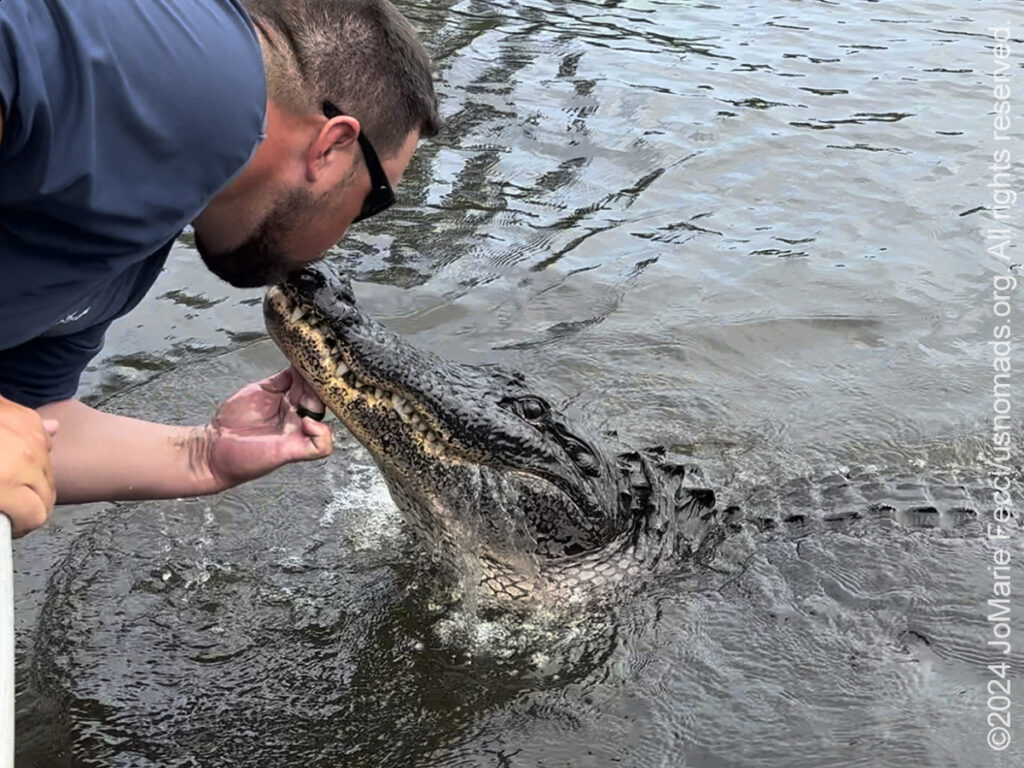
31 October 2024: Today is the “last” day here, and so it was fitting to make one more visit on the bayou via air boat. This time it was much more touristic (which makes sense as it is really close to New Orleans) but at the same time it was a really interesting area and the guide was local and had a lot of experience with alligators (in fact he had lost a finger to a gator as a kid). So this was really the “alligator swamp tour” moment, and that was ok. The airboats go out from a dock near a working seafood market, and then pass through the flood control system which is quite elaborate with all kinds of concrete dams and gates and follows the Bayou Segnette into the Barataria Preserve. The guide piloted his boat with skill and gave us a fun ride across the wide open area, “roosting” the water like we would “roost” sand in the dunes. He sped across and on top of some invasive plants that covered the water as if he was “mowing” grass, but the plants popped right back up when we had passed, and it seemed as if the airboat had never been there at all. He took us out to find some of the bigger alligators he “knew” and it became apparent that these guides had gotten very familiar with certain of the gators, and they knew their history and the history of the “conflicts” between some of the specific animals (as well as the history of the location and the last people who had “lived” out there “full-time” — and in fact they “named” areas based on the family name of some of the last residents). The highlight of the tour was how the guide handled the gators, he even gave one gator a “kiss,” and while this is not exactly the way we are supposed to engage with wildlife, it is clear that here the rules are a bit different, and it is their livelihood — as well as a nod to the “Cajun culture” historical relation to the land and animals there. Afterwards, returned to camp for a last night under the stars in Louisiana…
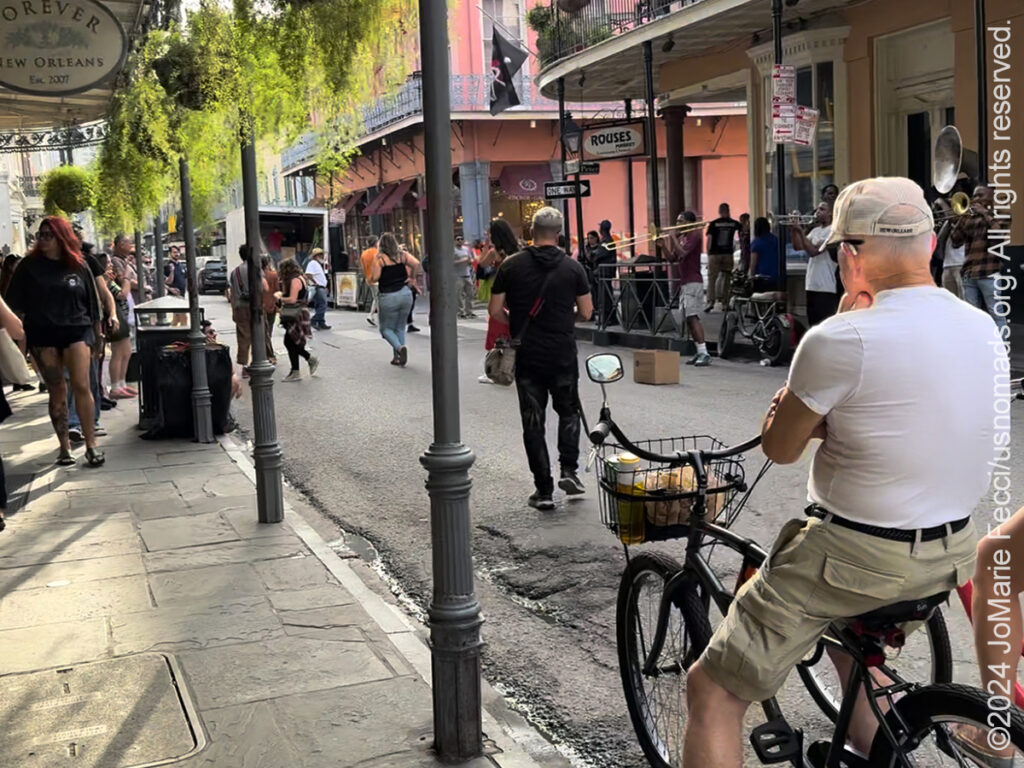
30 October 2024: Time to tackle New Orleans itself today. Starting with a drive to the neighborhood of Algiers, across the Mississippi from the French Quarter. There is a walkway on top of the levee with a perfect view of the city skyline and the steamboats docked on the riverside. We also discovered there was a ferry that would take us right into the French Quarter without having to drive and park in that crowded touristic area, so that was perfect. Took some time to explore on foot around the Algiers Point neighborhood which was really nice with interesting looking houses and a more abandoned commercial strip along the levee which I liked a lot for photography. After a bit of wandering, we took the ferry and in fifteen minutes we were in the touristic center of New Orleans where I went looking for some street music. It wasn’t hard to find, and after a short walk around Jackson Square I encountered exactly what I was in search of. I could hear the sounds of a brass band way before I could see them, and unlike some of the street musicians, they were sounding very good, so I followed the music until I saw the crowd spilling out of local establishments and stopping in the middle of the street to listen to the young musicians play. They were really excellent and I could have stayed there listening to them all day, but time was short and after a few songs I had to continue on my way to Lafitte’s Blacksmith Shop tavern on Bourbon Street, which is the site historically linked to the old pirate. Of course it was crowded and expensive and a tourist trap kind of place, but the history made it worthwhile to visit, though I only stayed for one drink before going back to wander the streets some more. I had to make sure to get the back to the ferry before too late, as the last boat back was pretty early, and I was back in Algiers in time to catch the sunset skyline. Stopped in at one of the few little bars that were open on the street near the ferry and liked the ambiance very much …
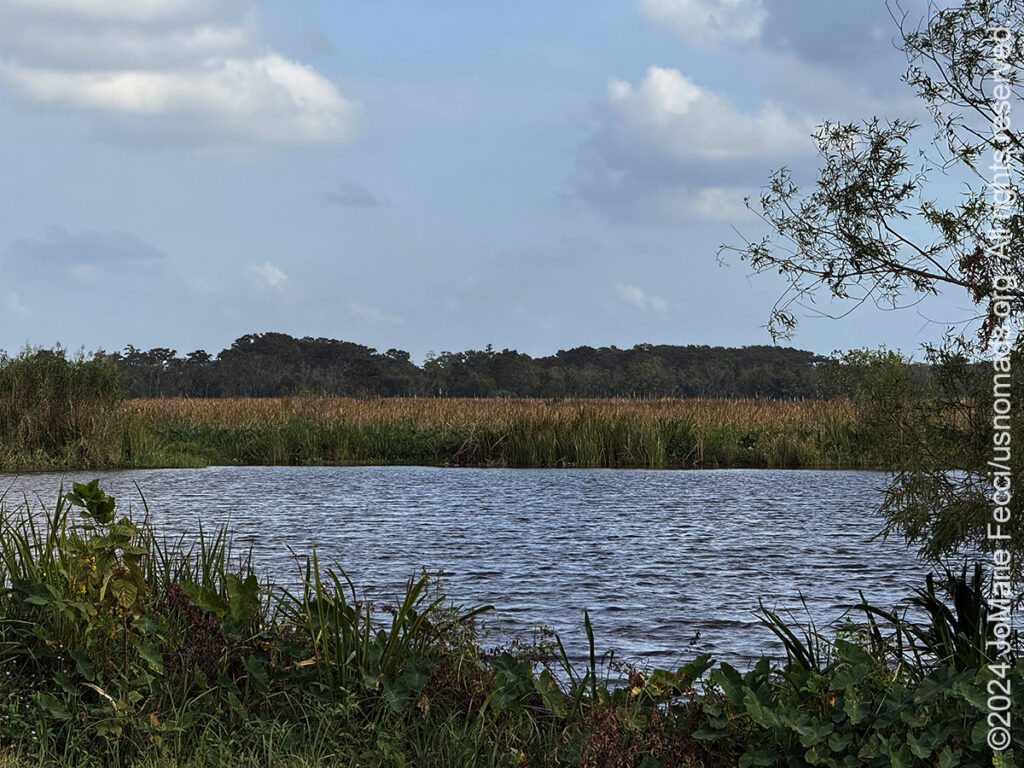
29 October 2024: Took a good part of the day to just re-supply and get organized for the final leg of this journey, and work out some logistics for the next few days. Then in the afternoon we did a little bit of exploring right around camp and tried to find access to the Bayou itself, but that seemed to be reserved for those people who had rented “cabins” which were actually nice houses with screened in porches that were situated right on the Bayou with their own docks. There was also boat access for people pulling their own boats, but not really any easy access otherwise. In the evening we just sat back and enjoyed the campfire and the mild evening air …
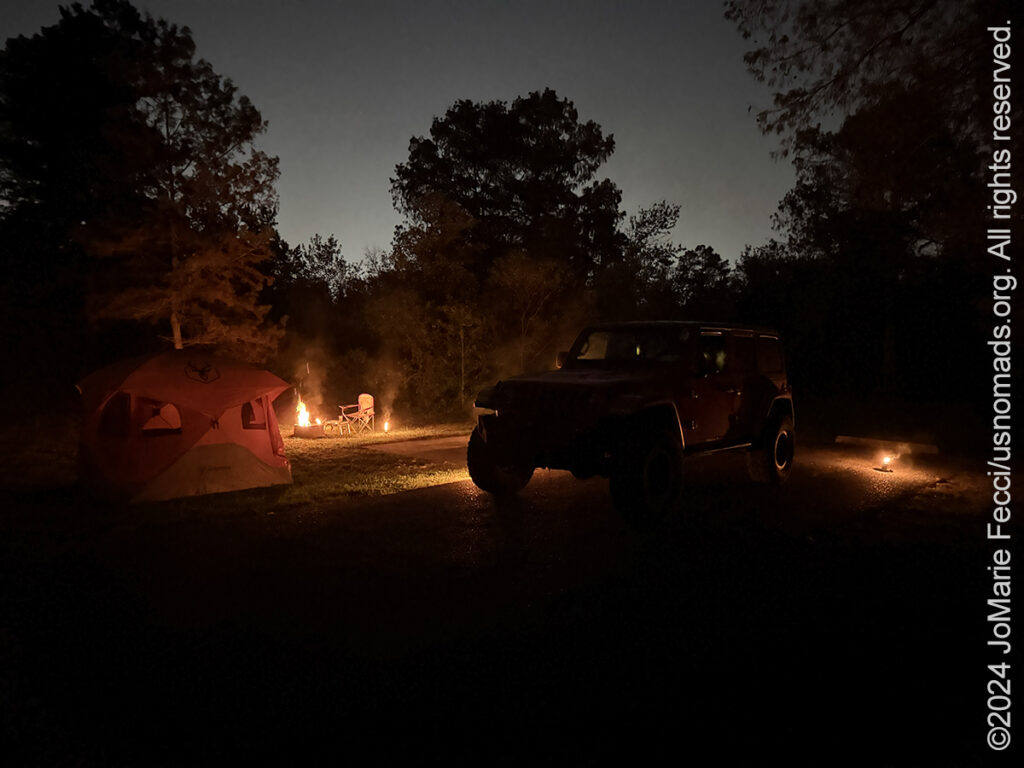
28 October 2024: Closing the loop today, back near New Orleans at the Bayou Segnette State Park for our last few days here in Louisiana. Bayou Segnette is just south of the city, but the park itself is in the woods right up against the water, and close to the Barataria Preserve. The campsites were spacious and comfortable, and it was a calm afternoon as we got set up and settled in for a beautiful night under the stars …
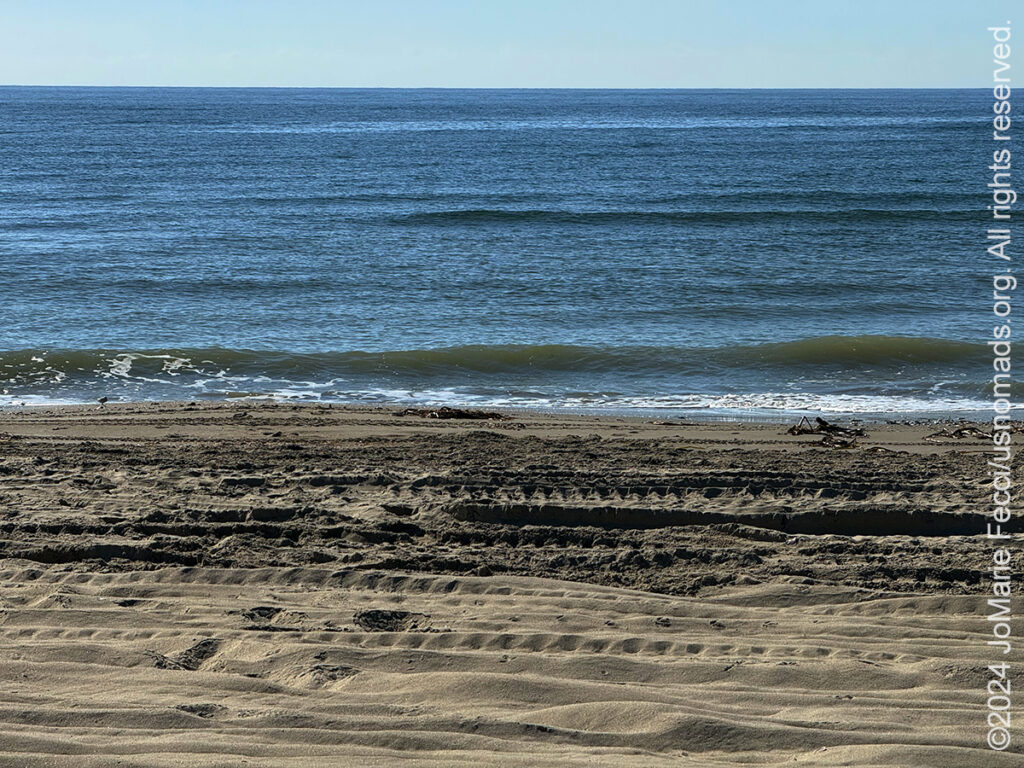
27 October 2024: We finally “found” the Gulf of Mexico — or more precisely the actual “coast” that we had been looking for all along. The Creole Nature Trail is a scenic byway that winds through several National Wildlife Refuge units near Lake Charles as well as a few areas of the kind of sandy beach we were hoping to find. It also passes the Intercoastal Waterway where we could see the huge ships up close as they made their way up the narrow channel northbound. At one point we also had to take a short vehicle ferry of the kind that was probably much more typical in the past before all the causeway bridges were built. It was interesting as we had to wait for “traffic” to cross, and that included an enormous tanker. The route was beautiful and there were plenty of places to stop and explore on foot. We past cattle ranches that seemed out of place in the wetlands, though historically this was once part of the earliest cattle trails that went from Texas to New Orleans from the 1780s to 1880s. In the afternoon we turned back towards Lafayette to the Wild Cat Brothers Distillery where we would take a deep dive into the history of sugar and rum (as well as taste some of the small batch rums they produce)…
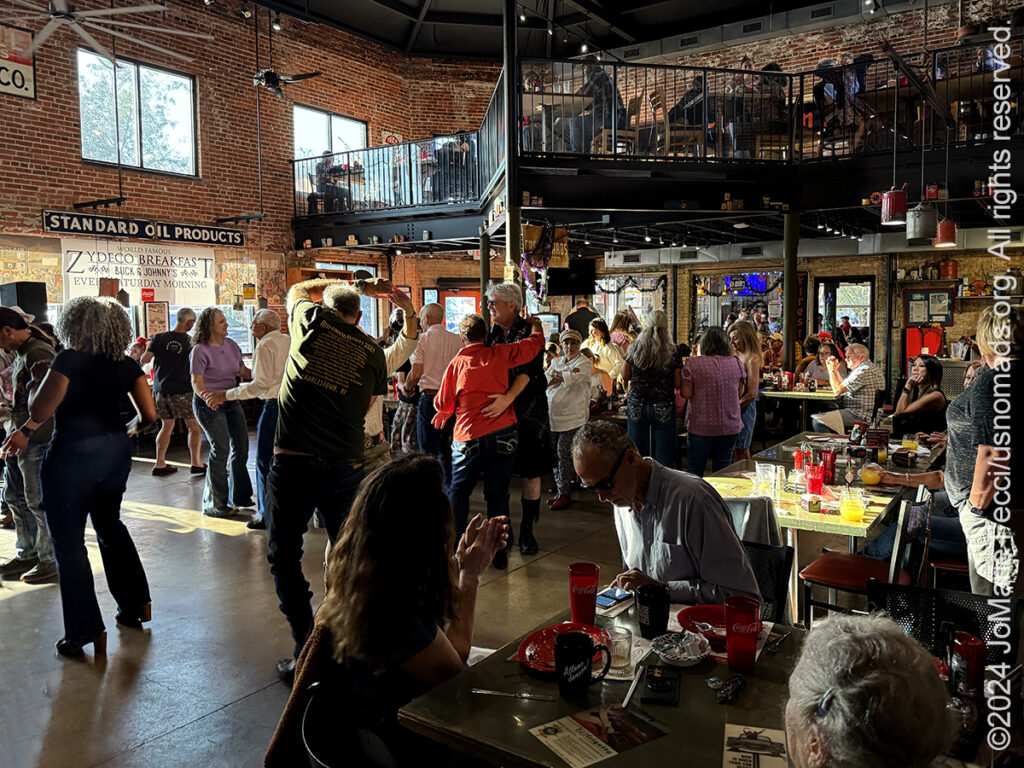
26 October 2024: In the morning we headed to Buck and Johnny’s and the Zydeco Breakfast did not disappoint. It was really rocking and everyone was having a blast. The music was awesome and there was plenty of dancing to get the weekend off to a great start. From there we started off north west towards the Kisatchie National Forest, intent on finding a nice place to set up camp, but we got there a bit late and everything was pretty full, so after a few hours of washboard roads without finding a suitable spot I decided to “pivot” and head back to the south where we could spend some more time exploring the “western” heritage of Louisiana at the local college rodeo championship finals and pickup with the Creole Nature Trail in the morning …
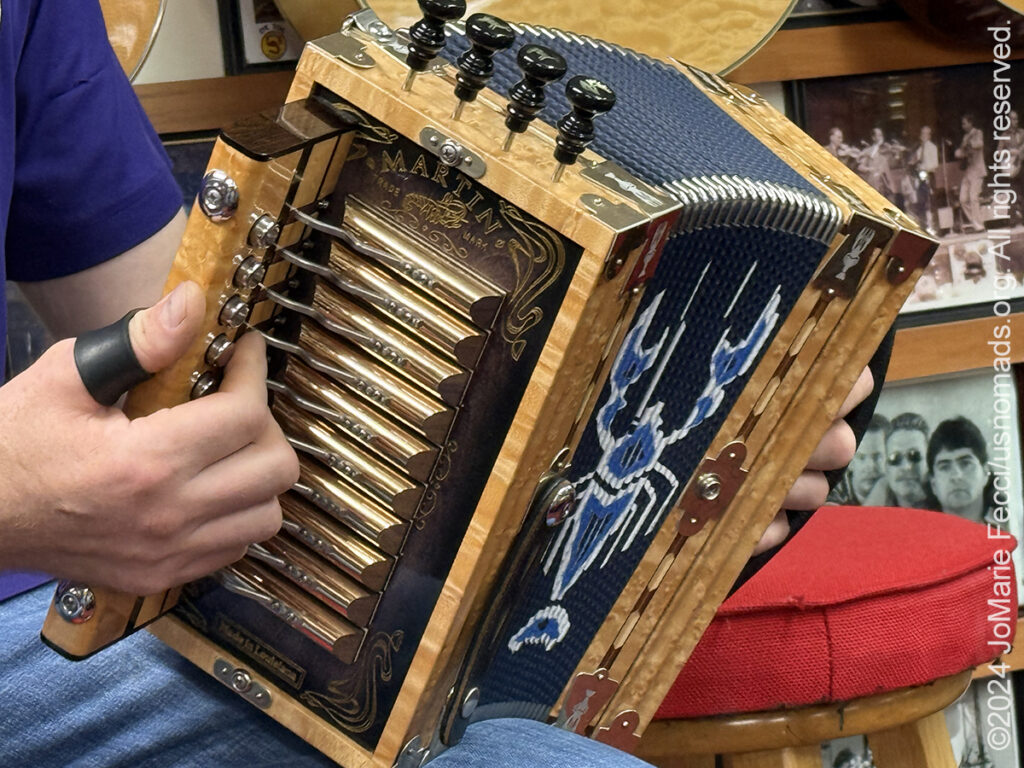
25 October 2024: The quest to learn more about the differences between cajun and zydeco music brought us to Martins Accordion shop, where three generations of the Martin family work together to hand craft accordions. One of the younger members of the family is also a musician who plays cajun, zydeco and country, and who took the time to talk to us about the music and the instruments his family build. It was a great opportunity to see how intertwined the music and cultures are, and to learn about the different ways the accordion can be played to get some amazing and unique sounds …
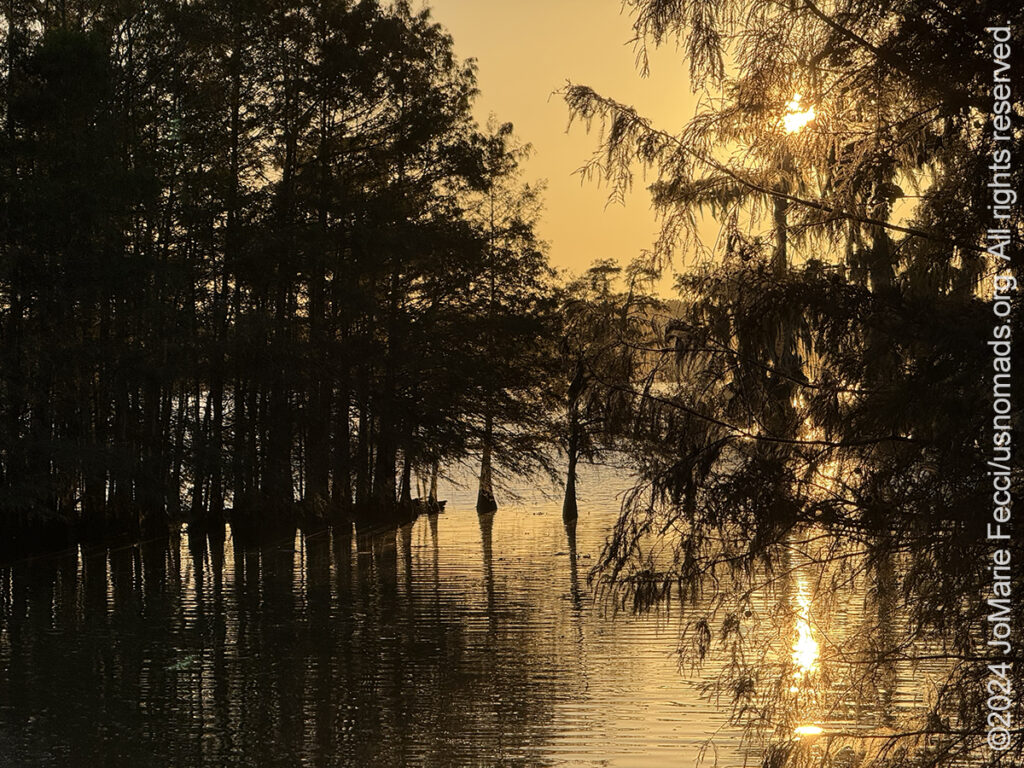
24 October 2024: Explored a few different locations today in search of some Zydeco, starting in Opelousas, which is known as the home of Zydeco. There weren’t any live performances happening locally at the moment, but there was a very interesting and comprehensive exhibit and presentation at the local visitor center. The visitor center was part of the “vieux village” — a park of sorts that assembles several historical buildings as well as a train engine with interpretive information that explaining the significance of each. Next stop was the Breaux Bridge area. It was late afternoon when we went exploring around Lake Martin, picking up some dirt roads that followed the contour of the lake for a bit. This was definitely a more “local” area with private property, fishing and hunt camps, deep in the woods. After sunset we returned to town to check out Buck and Johnny’s to hear some live music. Met some great people from the neighborhood who convinced us to come back on Saturday morning for the “Zydeco breakfast”…
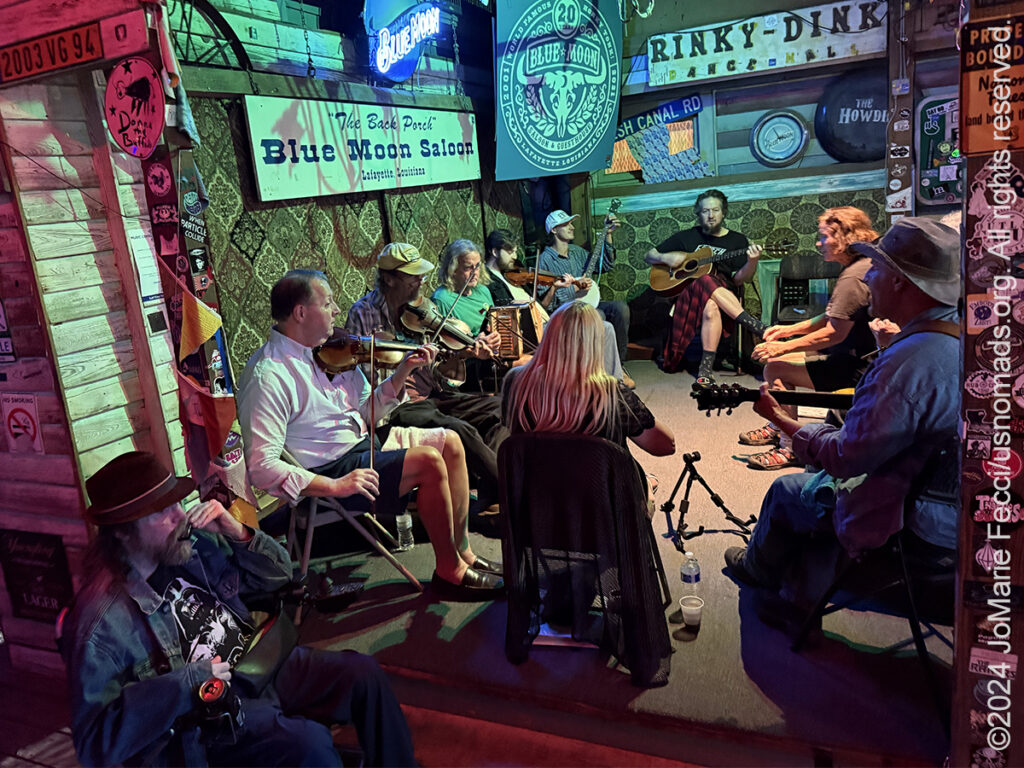
23 October 2024: A fun time at an “old favorite” place–the Blue Moon Saloon in Lafayette. We first discovered the Blue Moon during our Great American Roadtrip 2010, when we stayed at the saloon “hostel” and got to see the “back porch cajun jam.” It was a fantastic experience, and I returned there again a few years ago at the start of Mardi Gras celebrations when I was “passing through.” So we just had to make a stop there again this trip, and I timed it so that we could revisit the “back porch” for a cajun jam. It was a quiet Wednesday night but the porch was “full” as musicians got warmed up and began playing a mix of cajun and country music standards. The musicians ranged in age and style and several of them swapped instruments from time to time, alternately playing fiddle, accordion, banjo or guitar before trading back to their original instrument. The bar wasn’t too crowded at the start of the night, but most of the folks were “local,” including some dressed in costume coming from a halloween party. They weren’t shy and started dancing even while the musicians were just warming up. As the evening wore on, the music got better and a few more musicians joined the group on the porch and more people filled into the bar. A lot of folks knew each other and in between were some other tourists from France and elsewhere. It was a nice friendly mix and the dance floor got more crowded as some really good dancers stepped up. A really great evening overall…
THIS MONTH:
![]()
Roadtrip time! Heading south in search of the history of the Mississippi Delta region, with a focus on Louisiana and the different styles of music that evolved there as different cultures came together “back in the day.” Of course we will also be exploring some of the backcountry and enjoying the outdoors along the way…
COMING UP SOON:

Getting ready for this year’s Holiday Roadtrip south, where we are changing it up a little bit and spending more time on our favorite barrier islands along the Outer Banks as we celebrate the season with plenty of good cheer out on the sand …
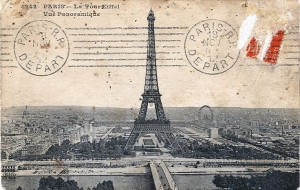
Returning to the “city of light” after a way-too-long hiatus and reconnecting with friends, favorite places and some urban exploring to change things up a little bit …
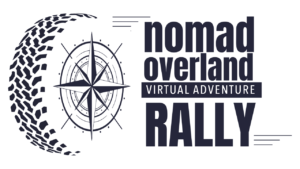
USnomads.org is very proud to be presenting the fourth edition of the Nomad Overland Virtual Adventure Rally in 2025. This is a unique kind of rally experience — a ten week event that participants can do from anywhere within the continental U.S.A. Competitors design their own routes as part of the rally, then drive it in a points-based online competition that includes optional activity tasks, quests and weekly challenges. The 2025 rally will run from 2 June – 10 August and is open to any driver within the United States who has an off-road capable vehicle — stock or modified. Registration for 2024 is currently open. For more information see the Rally website …
THE ATCHAFALAYA BASIN
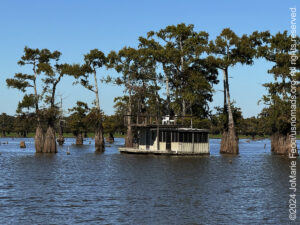
The Atchafalaya Basin is the nation’s largest river swamp, containing almost one million acres of America’s most significant bottomland hardwoods, swamps, bayous and backwater lakes. The basin begins near Simmesport LA, and stretches 140 miles southward to the Gulf of Mexico. Over the past 10,000 years or more, the Mississippi River has changed its path several times, ranging from the current location of Bayou Teche to today’s route past Baton Rouge and New Orleans. The Atchafalaya River runs down the middle of that traditional Mississippi floodplain and would probably be the main channel of the Mississippi by now, if not for the Old River Control Structure near Simmesport. Currently, the Atchafalaya Basin is bound by natural ridges formed by levee building along active and abandoned courses of the Mississippi River. As the federal government converted the swamp into a well-engineered floodway in the mid-20th century, rising water and overflow of silt changed the ecosystem, displacing the “water people” who had lived and raised families inside the Basin for at least three generations. Prior to the Civil War, a swamping economy developed in the Basin. This water-dependent economy consisted of hunting, fishing, frogging, trapping, and moss picking. There was plenty to eat, but one had to trade a commodity for money in order to buy things that they couldn’t get in the wilderness. The main commodity was fresh fish until the arrival of the cypress barons in the late 19th century. By 1930, the lumber companies had clear cut most of the cypress and the mills soon closed, leaving a sizable imprint on the natural landscape. Commercial fishing replaced timbering as the economic center for the Basin people after 1930. With a floating houseboat made of durable cypress they could still live within the river swamp despite the increasing frequency of floods. But by the late 1940s and early 1950s, the Basin began to fill up from increased water and siltation. The Basin people were forced to adapt, slowly abandoning their homesteads in the swamp…
COWBOY CULTURE
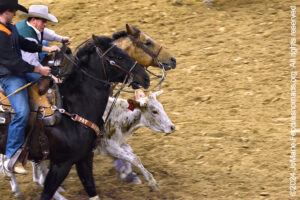
Some of the very first cattle drives in the US happened in Louisiana, where the cows were herded towards New Orleans, then the largest metropolis in the South and a major consumer of beef. The known cattle drive routes across Louisiana had to get through swamps and wetlands en route to New Orleans, making it a long and arduous trip. Beeves from central Texas were driven to the Matagorda Bay port of Indianola or Galveston, loaded onto steam transports and shipped up the Mississippi. Those that came from north Texas were driven to Shreveport and barged down the Red and Mississippi. Cattle herds also formed in southwestern Louisiana where the flat, green land was perfect for raising cattle and horses, many of them stewarded by Acadians and Creoles of color. There were no roads through the marsh to the coast, only trails whose routes were well traveled by cattlemen, trappers and farmers on horseback and by boat. Every Fall the cattle were driven to the coastal marshes where the grass was nutritious, plentiful, and green throughout the winter. In the Spring before the mosquitoes got too thick they were rounded up, branded and brought back to the prairie pastures for summer grazing or to be sold. The most treacherous part of these cattle drives was crossing canals with herds of 400 to 600 cattle. The cowboys used different tricks to get reluctant cattle to cross. Sometimes, if a canal or bayou was shallow enough, the riders would cut the tall, dense marsh grass with a sickle they carried on their saddle and make a thick grass mat for the cattle to walk on. Other times they would swim the cattle across by dismounting and guiding a horse in the lead. Most of the time there was a lead steer who had made the route many times and knew what to do. All the men had to do was talk to them. They would cross and the rest of the herd would follow. But that didn’t always work as planned and the men might spend a large part of the drive with wet clothes and gear. By the early 1900s, the New Orleans area stockyards in Arabi saw the arrival of 100,000 to 200,000 animals annually, roughly 85% of which were bovines, 10% hogs, and 5% sheep. Raised mostly in Louisiana and Texas, the beasts landed at 6700 N. Peters St., and were herded into pens, where they were consigned to any of around 20 on-site commission merchants. Among the largest in the South, the Arabi slaughterhouse operated under varied auspices until 1963. Today Louisiana’s cattle industry continues to raise lean, quality beef to meet consumers’ demands and the influence of cattlemen can still be seen in the shaping of Louisiana’s cultural and agricultural landscape. The Cajun Rodeo Association is just one of several organizations that run rodeos around the state year-round. And weekend trail rides are a popular event where people gather to visit, eat, listen to zydeco music, and celebrate their horses…
CAJUN OR ZYDECO
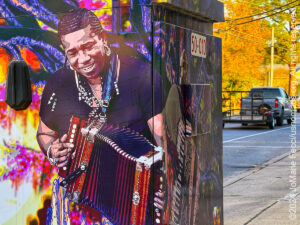
Although they are two separate genres, Cajun music is often mentioned in tandem with the Creole-based zydeco music. Both are from southwest Louisiana and share French and African origins. Understanding the difference between these two related styles of music native to Louisiana requires understanding the unique mixes of heritage in the region. Those with a long family history in the region might be “Cajun” or “Creole” or “Cajun Creole” (or none of the above, if their ancestors immigrated from somewhere else or in more modern times). Louisiana Creoles are descended from the inhabitants of colonial Louisiana before it became a part of the United States during the period of both French and Spanish rule. They share cultural ties such as the traditional use of the French Creole language and predominant practice of Catholicism. The term Créole was originally used by French Creoles to distinguish people born in Louisiana from those born elsewhere, thus drawing a distinction between Old-World Europeans and Africans from their Creole descendants born in the New World. The word is not a racial label — people of European, African, or mixed ancestry can and have identified as Louisiana Creoles since the 18th century. After Louisiana became part of the United States, the term “Creole” took on a more political meaning and identity, as the Catholic Latin-Creole culture in Louisiana contrasted greatly with the Anglo-Protestant culture of Yankee Americans. Cajuns are the descendants of the Acadian exiles who went to Louisiana after being expelled from Canada under the British. Cajuns make up a significant portion of south Louisiana’s population and have had an enormous impact on the state’s culture. Although the terms Cajun and Creole today are often portrayed as separate identities, Louisianians of Acadian descent have historically been known as, and are, a subset of Creoles. Presently, some Louisianians may identify exclusively as either Cajun or Creole, while others embrace both identities. Cajun music is rooted in the ballads of the French-speaking Acadians of Canada. Families sang traditional French songs called complaintes which the Cajuns adapted to their new ways of life. The first known record was of a violin in 1780 and a fiddle and clarinet player in 1785. The diatonic accordion was introduced to Cajun music in the mid- to late-1800s. It became popular because of its volume which, along with the fiddle, created sufficient accompaniment for dancing. Originally, musicians and singers performed at house dance parties known as bals de maison and the ballads were transformed to dance music. Zydeco music was a style developed by Black Creole musicians who incorporated new influences into a Cajun music base. In the beginning, Louisiana Creole and Cajun music were more similar than they are today. Both included many of the same songs. Both were sung mostly in French. Clifton Chenier is often credited as the “inventer” of zydeco. Clifton played the piano accordion and his brother Cleveland Chenier played the frottoir (rub board), and their band also included a saxophone. A piano accordion, a frottoir or a saxophone was never used in Cajun bands. Zydeco bands borrowed more songs and styles from the rhythm & blues and funk of New Orleans and a new style of music developed over time. According to folklore the name “zydeco” originated from Chenier’s song “Les z’haricots sont pas salés” (the string beans are not salted) — as “Z’haricots” was transcribed as “zydeco.” Today many bands include multiple instruments and music styles and multiple types of accordions and it is hard to know if a band considers itself to be Cajun or zydeco or both Cajun and Zydeco (and Swamp Pop) at the same time. But, as a general rule, if a band features the diatonic accordion and fiddle and sings mostly in French, and most of the members are white, that is a Cajun band. If a band features an accordion other than a diatonic accordion, features a frottoir player, and sings at least some of its songs in French or Louisiana Creole (Kouri-Vini), and most of its members are black, that is a zydeco band. And in Louisiana people of every shade enjoy dancing to both…
Nesconset | Paris | Belgrade | Lanoka Harbor | Cape May | Carolla | Mandeville | New Orleans
MORE NOTES FROM THE ROAD:
15-22 October – Roadtrip South
8-14 October – Roadtrip South
1-7 October – Roadtrip South
September – New York
August – New York
26-31 March – Eastbound
20-25 March – NM
15-19 March – DVE
9-14 March – AZ
1-8 March – NV & AZ
23-29 February – Glamis
16-22 February – Roadtrip SW
1-15 February – Roadtrip SW
January – Paris
22-31 December – Holiday Roadtrip
15-21 December – Holiday Roadtrip
1-14 December – Holiday Roadtrip
8-30 November – New Jersey
1-7 November – Cape Cod
27-31 October – Cape Cod
16-26 October – Long Island
Archive
ROADTRIP
An epic journey crisscrossing the USA from east to west and back again, exploring some of the beautiful wild spaces that make up our “public lands.” The roadtrip covered almost 15,000 miles, much of it off-grid and off-pavement, focusing on the deserts of the American southwest. Some locations were truly “iconic” while others were little known, and the segments of independent exploration where punctuated with some fun events across the region… [read]
SPECIAL REPORT
All about exploring ghost towns and abandoned places in the USA and beyond, with tips, and information on the many different types of sites to be found across the globe, including detailed guides for eight specific sites… [read]
REFLECTIONS
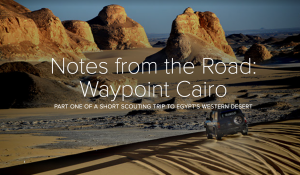
EGYPT: CAIRO REFLECTIONS
A quick overview of impressions from a stop in Cairo during our recent scouting mission in Egypt and Sudan … [read]
SPECIAL REPORT
A look into south-eastern Algeria on the border with Libya and Niger: overlanding with the Tuareg in one of the most remote corners of the Sahara … [read]
LOCATION
This installment of a series that focuses on locations around the USA takes a look at some favorite places near our home base in NY. We share a few places we like to explore, where you can experience something of the raw natural beauty of coastal beaches, pine barrens and a little bit of obscure military history… [read]